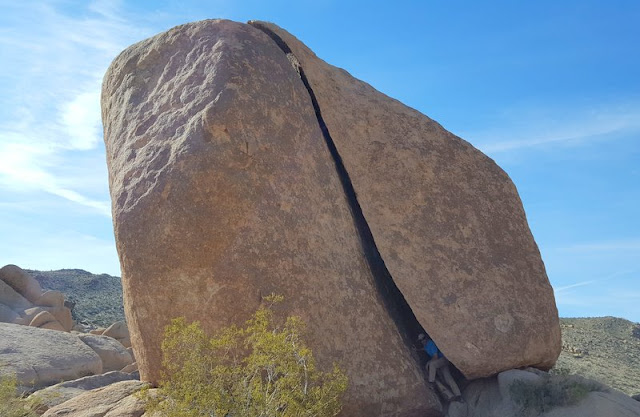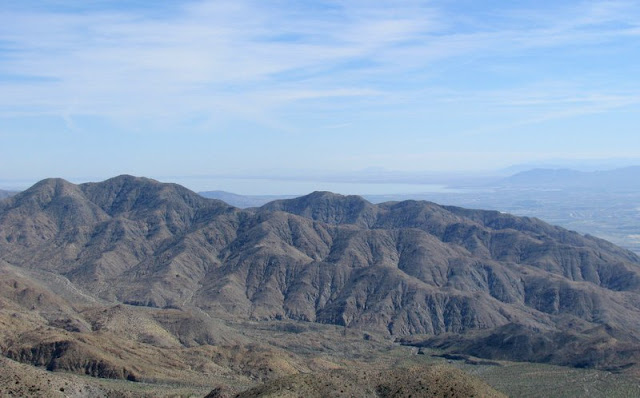 We have a list of must-see places while we are meandering through California. The neat things that we get to experience in addition is just gravy on top of that. Joshua Tree National Park is the reason we have come to this southeast part of California, and we can actually see the western side of it from our campground.
We have a list of must-see places while we are meandering through California. The neat things that we get to experience in addition is just gravy on top of that. Joshua Tree National Park is the reason we have come to this southeast part of California, and we can actually see the western side of it from our campground.But this huge national park has only two entrances, one to our north and the other to our south. This northern part of the park is at a higher altitude, and it took us about 45-minutes to drive up there. Even before we got into the park, we were greeted by the unique Joshua trees, growing in forests in the desert.
These Joshua Trees can grow to be quite large, as you can see this big guy looming large over Denisa's big guy.
Our stop at the national park visitor center taught us several things about this unique plant. For example, the Joshua Tree was named by the Mormon settlers, who thought it looked like the prophet Joshua with up-raised arms.
A close-up of the trunk shows that it has bark that looks very much like a tree.
But they are actually a cactus in the agave family. If we would cut open the Joshua tree's trunk, it would look like a tube. The Joshua tree trunk is made of thousands of fibers, rather than a solid center like a tree. Because they can't count rings to determine the age of a Joshua Tree, scientists estimate their age by dividing its height by the average annual growth rate of 1.5 inches. The typical lifespan of a Joshua tree is 150 years, and they grow to be 45 feet high. That's a tall cactus!
Young Joshua trees look very much like a yucca cactus until they start growing appendages and their trunk starts looking like bark.
We had good timing to get to see many of the Joshua trees blooming. It actually takes a damaging winter freeze to stimulate the trees to produce flowers, which only grow at the tips of the branches. We saw some of the blooms at their earliest stage.
American Indians roast and then eat these flowers. Rumor has it they are a sweet treat that tastes like a banana.
As the blossom completely flowers out, it has an interesting partnership with the pronuba (yucca) moth. The moth fertilizes the flower while laying her eggs inside. The moth eggs develop into larvae that will feed on some of the yucca seeds. The other fertilized seeds are left to grow into trees. So the Joshua tree can only make seeds with the help of the moth, and the moth's larvae only eats Joshua tree seeds.
These unique Joshua trees are found in only a few places on earth, so it was fun to see them for ourselves. This national park protects their habitat so people will be able to see them for many more years. But we were surprised to find that this park has another star attraction. The landscape is littered with huge rock formations, and fun hiking trails that allow visitors to get up close to them.
Our first trail took us to Hidden Valley. It is here that cattle rustlers brought their stolen herds to be re-branded. The rock walls made a perfect hiding place, and Denisa is standing in the middle of one of the Hidden Valley's natural corrals.
It was neat to see these mammoth boulders that just seemed to erupt out of the desert floor. Mark is a rock scrambler, so you will see many pictures of him on top of these big boulders.
His bright blue shirt shows up well against the brown sandstone, but he almost gets lost against that beautiful blue sky.
Rock scramblers enjoy the rocks, but more serious rock climbers travel from all over the world to tackle the climbs throughout Joshua Tree National Park. We watched as several climbers were moving up this stone face.
They have all the ropes and lanyards to keep them safe. But they had to use the tiny cracks and crevices to lift themselves up that vertical wall.
We watched as another rock climber made a solo climb up a different vertical wall.
It was fun to see that he eventually made it to the top, as he sat on the pinnacle looking over the valley.
The ranger told us to be sure to make the hike to Barker Dam. The dam was built around 1900 to hold water for cattle.
The reason we were urged to make this hike was to actually see water. For the last six years, this reservoir has been dry. But the rains of 2017 have brought a much-needed watering hole for the wildlife that live in this desert.
We had hoped to see some of the desert big horn sheep that call this national park home. But again, the mountain sheep eluded us. In fact, the only wildlife picture of the day is another lizard. Mark thinks Denisa needs to quit taking pictures of lizards, but they are the only animals that we've been seeing.
When we hiked another three-mile loop, we found several rocks that have curious names. For instance, Mark climbed into the eye socket of "Skull Rock."
We compared profiles between Denisa and "Face Rock" behind her.
This loop also included "Split Rock," named for obvious reasons. Of course, Mark had to climb into the split.
He barely fit in the split. He mentioned that probably wouldn't be a good place to be during the next California earthquake.
This was our third trail of the day, and part of the time we were hiking in the wide-open desert. Joshua Tree National Park has many acres of wilderness, so it's not all huge boulders and Joshua trees.
We also made the drive to the highest point in the park at Keys View. From there we could see the mountains around us, and other landmarks far in the distance. Over the ridge of the mountains, we could barely see the sliver of the great Salton Sea. We visited there a couple weeks ago.
Our eyes could see it clearly, so we zoomed in with the camera. That faint mountain barely visible on the horizon is Signal Hill. We remember it fondly from our stay in El Centro when we could see it every day. We also saw it up close when we peered into Mexico on our Border Patrol tour. So from our viewpoint in this national park, we could see all the way south into Mexico.
We were hiking among more of the boulders as the sun was getting lower in the sky. It was lighting up those giant rocks against the blue skies. Yes, we have wandered into another of His wonders!
It was almost as if the setting sun was spotlighting this big boulder. Denisa crawled up into the indention in the rock that made its own little stage.
When one is on a stage in the spot light, it must be time to jump for joy! Even her shadow was jumping for joy!
We are hanging out in the desert, waiting for the "super bloom" that some are predicting. The rains from this winter have restored lakes, and awakened flower seeds hiding in the desert. But in this high elevation desert, it is too early and too cool for those wildflowers. This was the only flower blooming in the northern section of Joshua Tree National Park on our visit this day.
We had a full day, and felt like we saw all the highlights of this part of Joshua Tree National Park. We are happy to check another fine national park off our list.











































0 Response to "Joshua Tree National Park"
Post a Comment